Are you a Quiet Speculation member?
If not, now is a perfect time to join up! Our powerful tools, breaking-news analysis, and exclusive Discord channel will make sure you stay up to date and ahead of the curve.
And now, to formally close the books on a terrible year. Yes, it is in fact 2021; time did truly progress, and we're not trapped in a Doctor Who-style loop. However, a new month means a new metagame update, which means that I must remind everyone of the past year. Sorry!
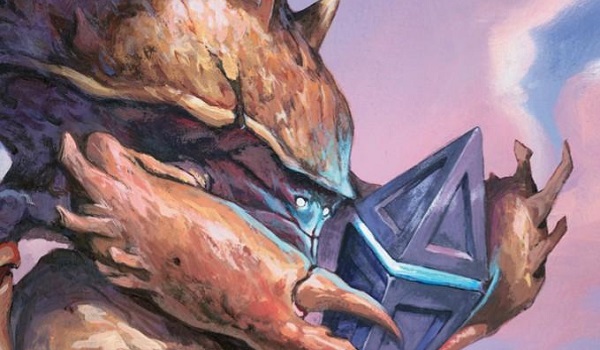
The data set is significantly down for December. November was the largest set I've ever worked with at 681 decks, which would have been hard for any month to top. December didn't even try, yielding are only 558 decks. It's not the smallest total for a full month; August still holds that distinction. However, December also doesn't have August's excuse. Up until October, Wizards wasn't especially consistent about how many events were posted per week, while August and September had a lot of missing Preliminaries and Challenges. December's events were posted like clockwork and completely, as far as I know, but numbers were way down.
After the first week of December, I don't think a single Preliminary posted a 5-0 deck, and often only ~5 decks were listed. Which is not too surprising considering the holidays. Even the most dedicated streamers and grinders have to rest sometime, and I saw a lot of unusual decks crop up as a result. With the sharks away, the minnows will play. It does mean that December's data will be a bit weird.
December Metagame
To make the tier list, a given deck has to beat the overall average population for the month.  The average is my estimate for how many results a given deck “should” produce on MTGO. To be a tiered deck requires being better than “good enough;” in December, the average population was 7.97, meaning a deck needed 8 results to beat the average and make Tier 3. Then, we go one standard deviation above average to set the limit of Tier 3 and cutoff to Tier 2. The STdev was 10.20, so that means Tier 3 runs to 18, and Tier 2 starts with 19 results and runs to 29. Subsequently, to make Tier 1, 30 decks are required.
The average is my estimate for how many results a given deck “should” produce on MTGO. To be a tiered deck requires being better than “good enough;” in December, the average population was 7.97, meaning a deck needed 8 results to beat the average and make Tier 3. Then, we go one standard deviation above average to set the limit of Tier 3 and cutoff to Tier 2. The STdev was 10.20, so that means Tier 3 runs to 18, and Tier 2 starts with 19 results and runs to 29. Subsequently, to make Tier 1, 30 decks are required.
The smaller population meant that both the cutoff and the deviation was lower than normal, though the deviation was still higher than in September. Hard to say if that means anything for the data or results, but it's worth noting, and suggests that September was relatively more stable than every other month.
The Tier List
Just as the total population is down, the number of decks in the sample are down. However, not as down as I'd expect. Despite December dropping 123 results compared to November, it's only down 10 decks to 70. Which says a lot about how many rogue or at least untiered decks continue to place, which in turn says positive things about Modern's health and diversity. Of those 70 decks, 23 made the tier list, which is up one from November. The lower average coupled with a fairly high deviation is likely the reason, but it does go to show how volatile these standings really are.
I'd also like to take a moment to mention that there aren't any aggregate decks here except 4-C Omnath, which keeps getting harder to classify and separate. The true control decks and the ramp-ish versions keep moving closer together, which pressures the other versions to merge. I've resisted so far, but the term Uro Pile is getting harder and harder to argue against.
I meant to bring this up last month and forgot, but Kiki-Twin is a Tier 3 deck. Which is very impressive given its small player base. It turns out that Bolt-Snap-Bolt is still a very powerful line, as is the ability to quickly combo after playing a tempo game. It's not as powerful as true Splinter Twin, but that might be due to lack of polish or metagame woes. Despite everything, it's still a very solid deck. Interesting to note as well, Kiki-Twin is built around Boil, both dodging it and wielding it against 4-C Omnath and Dryad of the Illysian Grove decks. It's not a bad strategy, but fairly ironic that now it's quite soft to Blood Moon, while UR Twin was the Blood Moon deck in Modern for years.
They're Still There
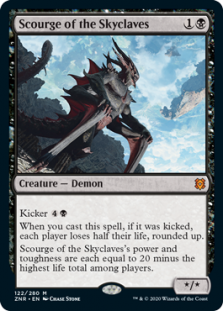 The other thing to note is that 4-Color Omanth is the top deck followed by Scourge Shadow. Again. And also again, they're down from their October heights. This is partially due to the overall population decline and partially due to the metagame gradually adapting to both. Which factor is stronger is impossible to determine. However, the fact that this has been a trend for several months, and reflects earlier examples of Uro decks rising and falling, seems to point to the latter explanation. The question is whether this is what players want, as the method of adaptation appears to be running Blood Moon (as I'll demonstrate below).
The other thing to note is that 4-Color Omanth is the top deck followed by Scourge Shadow. Again. And also again, they're down from their October heights. This is partially due to the overall population decline and partially due to the metagame gradually adapting to both. Which factor is stronger is impossible to determine. However, the fact that this has been a trend for several months, and reflects earlier examples of Uro decks rising and falling, seems to point to the latter explanation. The question is whether this is what players want, as the method of adaptation appears to be running Blood Moon (as I'll demonstrate below).
Tier 2 Vanishes Again
Once more, there is only a single deck in Tier 2: Hammer Time has done quite well for itself by moving up a tier in a month. However, I wouldn't read too much into that. It's received a lot of attention, which always boosts numbers. The deck is also very well positioned. Much like Infect, Hammer Time wrecks low- or no-interaction decks and runs over slow decks. It 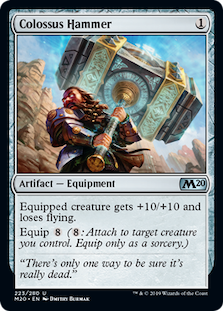 suffers greatly against decks with lots of cheap interaction, and those decks have been down recently. Plus, it's able to take advantage of 2020's most consistently good card advantage engine better than most decks. We'll see if it can weather the spotlight, or if the deck is too clunky and anemic when the combo doesn't come together to survive.
suffers greatly against decks with lots of cheap interaction, and those decks have been down recently. Plus, it's able to take advantage of 2020's most consistently good card advantage engine better than most decks. We'll see if it can weather the spotlight, or if the deck is too clunky and anemic when the combo doesn't come together to survive.
As for it being alone, that's just a quirk of the data. December's population being low made the data very skewed and polarized. More of the data is caused by the most invested players, and they're more likely to either play their pet deck or just the best one. This pushes the numbers to either end of the spectrum and away from Tier 2. Therefore, decks that I will argue should be Tier 2 fell outside the bracket. Mono-Red Prowess, Reclaimer Titan, and BR Midrange are just over the line for Tier 1, and Mono-Green Tron is right at the Tier 3 cutoff. In fact, there is a huge gap between Hammer Time and Tron, which I can only chalk up to skewed data. The power rankings back me up.
The Midrange Resurrection
Why do players insist midrange is dead in Uro's world? Every time it looks like Jund is finished, something replaces it. Last month it was Jund Scourge, which was straight Jund but with Scourge of the Skyclaves. This month, it's Rakdos Rock.
Rakdos Rock, Ozymandias17 (MTGO Challenge, 8th Place)
And this deck is just Jund but trading flexibility and power for mana consistency. I'm tempted to just keep calling it Jund, because it plays exactly the same way. And I'm going to, because it annoys certain people I like annoying. By dropping green, Jund is giving up flexible removal in Abrupt Decay, Assassin's Trophy, and sideboard Veil of Summer and raw power in Tarmogoyf and Bloodbraid Elf. In exchange, they get to play Blood Moon, which again, is a very good metagame decision. So long as small creature decks are running around, I expect Jund to remain a player, and so long as 4-C Omnath remains on top, I'd expect two-color Jund over three.
It might look like this version came out of nowhere to make Tier 1, but that isn't the case. A lot of the players who played Jund Scourge in November were on Rakdos in December. Plus, Rakdos Rock has been a deck I've been recording, but didn't make the Tier list for months. This is a case of players changing horses rather than a new deck magically appearing.
Power Rankings
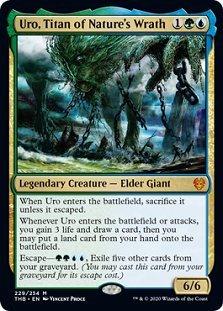 Tracking the metagame in terms of population is standard practice. However, how do results actually factor in? Better decks should also have better results. In an effort to measure this, I use a power ranking system in addition to the prevalence list. And the practice proved particularly relevant this month, as it backed up a lot of what I've said about Tier 2.
Tracking the metagame in terms of population is standard practice. However, how do results actually factor in? Better decks should also have better results. In an effort to measure this, I use a power ranking system in addition to the prevalence list. And the practice proved particularly relevant this month, as it backed up a lot of what I've said about Tier 2.
A reminder of how it works: as I go through the Preliminary and Challenge results, I mark each deck’s record or placement respectively. Points are then awarded based on those results. Preliminaries report results based on record, so that’s how the points are distributed. 5-0 is three points, 4-1 is two, and 3-2 is one. Challenges are reported in terms of placing, so being Top 8 is worth three points, Top 16 is two, and being reported at all is one. The system is thus weighted to award more points to decks that perform well in Challenges rather than Preliminaries. The reason is simply that Challenges are larger and more competitive events, and the harder the field, the better a deck needs to be.
The Power Tiers
Just like with population, the point total fell in December. And by a higher percentage (18% vs 21%) thanks to the tiny Preliminaries awarding fewer points. The 558 decks earned a total of 873 points in December. The average points were 12.47, so 13 points makes Tier 3. The STdev was 16.23, meaning Tier 2 began at 30 points and Tier 1 is for 47 points or more. There were 23 decks just like the population tiers, but Jund didn't make the cut on points. In its place is Eldrazi Tron, which in turn just missed the population cutoff.
Rakdos Rock and Reclaimer fell out of Tier 1 when power is considered. As stated earlier, skewed data artificially shrunk Tier 2, and the power rankings correct some of that drift. On the whole, however, it is striking how similar the power rankings are to population this month. Typically, there's a lot of variation, and decks jump around within their tier, so the lists look very dissimilar. But the most notable change this time around is Crab Mill's jump from Tier 3's basement into upper Tier 3. Tier 3 is always the most volatile tier, and decks move around a lot in there, but this time the upper half is in the same order in both lists other than Crab Mill passing Izzet Prowess.
The Millstone
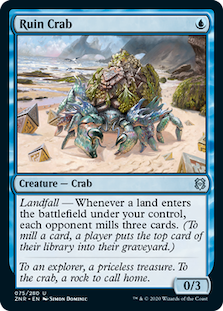 It makes sense that Crab Mill would do well. The metagame being skewed toward 4-C Omnath and Primeval Titan decks is ripe ground for Mill. Essentially, Mill is just an aggro deck using a different life total. By which I mean library size. The slower the deck, the more vulnerable to Mill's attack it becomes. In many cases, because it helps Mill out by drawing cards. In a more aggro metagame, Mill will suffer. Thanks to Archive Trap and all the Crabs, Mill's best hands are faster kills than the typical aggro deck. However, its average hand is a bit slower, and the attack more easily avoided.
It makes sense that Crab Mill would do well. The metagame being skewed toward 4-C Omnath and Primeval Titan decks is ripe ground for Mill. Essentially, Mill is just an aggro deck using a different life total. By which I mean library size. The slower the deck, the more vulnerable to Mill's attack it becomes. In many cases, because it helps Mill out by drawing cards. In a more aggro metagame, Mill will suffer. Thanks to Archive Trap and all the Crabs, Mill's best hands are faster kills than the typical aggro deck. However, its average hand is a bit slower, and the attack more easily avoided.
The meta also has much better tools for dealing with Mill than aggro. The gold standard of anti-aggro cards is arguably Timely Reinforcements, as it undoes a huge chunk of damage and board advantage. The Rise of the Eldrazi titans and Gaea's Blessing undo all the damage Mill's done, and most can be run as singletons and still have the maximum effect. Depending on build, Leyline of Sanctity may be unbeatable. Mill will always be around, but I have serious doubts that it will be a serious threat for very long; as soon as it gains too much steam, players can elect to beat it blindfolded.
A Unique Problem
However, the power rankings aren't necessarily the most accurate this time. Going back to what I said at the beginning, the opportunity for decks to earn points was diminished and very unequal. The Challenges had exactly 32 listings as always. However, that also means that they awarded the normal spread of points. The Preliminaries only have 4-0's, meaning no 3 point decks, so the power ranking is necessarily skewed towards decks that perform well in Challenges. Normally, the higher number of Preliminaries balances this natural (and deliberate) bias. This is relevant because the Tier 1 decks from population tend to show up more in Challenges than Preliminaries (particularly 4-C Omnath), and thus they were more easily able to maintain their spots than under normal circumstances. I'll be keeping an eye on this for January.
Average Power Rankings
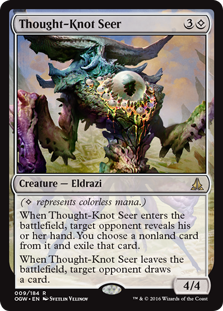 Finally, we come to the average power rankings. These are found by taking total points earned and dividing it by total decks, which measures points per deck. I use this to measure strength vs. popularity. Measuring deck strength is hard. Using the power rankings certainly helps, and serves to show how justified a deck’s popularity is.
Finally, we come to the average power rankings. These are found by taking total points earned and dividing it by total decks, which measures points per deck. I use this to measure strength vs. popularity. Measuring deck strength is hard. Using the power rankings certainly helps, and serves to show how justified a deck’s popularity is.
However, more popular decks will still necessarily earn a lot of points. This is where the averaging comes in. Decks that earn a lot of points because they get a lot of results will do worse than decks that win more events, indicating which deck actually performs better. A higher average indicates lots of high finishes, where low averages result from mediocre performances and high population. Lower-tier decks typically do very well here, likely due to their pilots being enthusiasts. So be careful about reading too much into the results.
The Real Story
When considering the average points, the key is looking at how far-off a deck is from the Baseline stat (the overall average of points/population). The closer a deck’s performance to the Baseline, the more likely it is to be performing close to its “true” potential. A deck that is exactly average would therefore perform exactly as well as expected. The further away the greater the deviation from average, the more a deck under- or over-performs. On the low end, the deck’s placing was mainly due to population rather than power, which suggests it’s overrated. A high-scoring deck is the opposite.
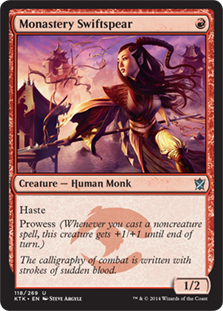 As always, the lower-tiered decks did better in the average ranking thanks to few results spreading out the good results. It might look like a lot more decks did above averagely than normal in December. However, a lot of this is again due to the low turnout. The baseline is the lowest it's ever been at 1.54. The average of the previous months is 1.65, and that obviously changes how I see this data. That 4-C Omnath and decks that prey on it (Crab Mill specifically) are overperforming is beyond dispute. However, how many other decks are overperforming is a greater question.
As always, the lower-tiered decks did better in the average ranking thanks to few results spreading out the good results. It might look like a lot more decks did above averagely than normal in December. However, a lot of this is again due to the low turnout. The baseline is the lowest it's ever been at 1.54. The average of the previous months is 1.65, and that obviously changes how I see this data. That 4-C Omnath and decks that prey on it (Crab Mill specifically) are overperforming is beyond dispute. However, how many other decks are overperforming is a greater question.
The Metagame Evolves
There was quite a bit of change over the first five months of the Metagame Update's return. Rakdos Prowess was consistently Tier 1, but nothing else held that distinction. Uro decks have changed significantly, though it's my observation that the rate of change is slowing. However, it's a new year now, and there are more sets incoming to shake things up. We'll all have to see how Kaldheim affects Modern starting next week.




